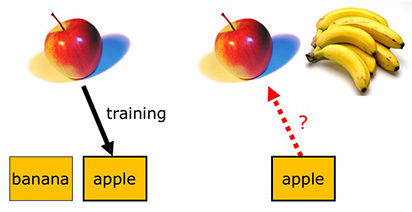Symmetry in Reasoning, and Reasoning in SymmetryMasasi Hattori

Imagine that your friend told you that he would call you if he passed his examination. Many people, upon hearing their friend call, would answer the phone and unhesitatingly say “congratulations.” However, the phone call could be about something else. Thus, logically speaking, “if he passes the exam, he will telephone” does not imply “if he telephones, he has passed.” Nevertheless, humans are quick to make such converse inferences, even though they are logically fallacious.
The evidence suggests that only humans make converse inferences. It is known that non-human animals find it difficult to engage in converse inference or symmetry inference. Researchers have investigated this area using a method established by behavior analyst Murray Sidman. The procedure is a little bit complex, but the most simplified version is as follows: after the subject learned that an apple is called “apple,”, it is tested whether it can select an apple from among multiple fruits when it hears the word “apple”.
This test appears so easy that you are probably wondering how this could even be a test in the first place. First, learning that an apple is called “apple” entails the forward association: “object→label.” On the other hand, receiving the instruction “apple” and then selecting the apple from among multiple fruits demonstrates successful performance of the reverse association: “label→object.” When humans master an association in one direction, they do not need to learn the reverse association. However, this is not the case with non-human animals.
The finding that even an animal such as a chimpanzee failed to successfully implement symmetrical relations was surprising for two reasons. First, it was naturally surprising that this seemingly elementary task proved too hard even for the primate that is most closely related to humans. I do not know how deeply the fact that the acquisition of symmetry is unique to humans is related to the fact that humans alone are capable of manipulating complex language, but associative symmetry is closely related to vocabulary learning if nothing else. The ability to perform symmetry inference between objects and their labels is a prerequisite for the effective mastery of word meanings. Besides, symmetry between two objects cannot be isolated from the interpretation or generation of conditional and causal statements. Of course, to perform symmetry, one must be capable of abstraction, which includes symbolic functions, and of imitating (modeling) a counterpart's utterances and actions. Thus, when one considers that non-human animals can master transitivity, which is predicated on the same abilities as are abstraction and imitation, the peculiarity of symmetry becomes even more striking. There is no doubt that symmetry inference, abstraction ability, and language have a mutually dependent and complex relationship.
The second surprising thing is the implication that only humans commit logical fallacies. Symmetry inference is logically fallacious. For example, humans are animals, but not all animals are human. The converse of the statement is not always true. Why do humans, supposedly the most intelligent species, commit such logical blunders? This phenomenon begins to make sense when one considers the close relationship between symmetry inference and creativity. There actually is no discovery in deduction. That is to say, a logical conclusion is essentially pre-embedded in the premise. By contrast, symmetry inference, though logically fallacious, has a generative nature.
Interestingly, patients of schizophrenia tend to exhibit excessive symmetry in their reasoning. This finding seems to take on more significance when considering the relationship between symmetry and innovation. It is understood that schizophrenia has a strong genetic component. Furthermore, schizophrenia is a global phenomenon, its lifetime prevalence being the same (approximately 1%) irrespective of race or culture. Given these facts, it is natural to assume that the disease must have emerged at a very early stage in human beings' evolutionary history, and that its genetic component must have offered some kind of adaptive advantage to our species. There are various hypotheses concerning what this advantage might be, and much of the attention has been focused on creativity, language, and social intelligence as a candidate.
In fact, these three cognitive abilities seem to be relevant to symmetry. The origin of human intelligence and the rapid changes in the cultural environment that followed are still shrouded in mystery. However, it is not unreasonable to assume that the ability to perform symmetry inference was involved as a prerequisite for the phylogenesis of intelligence and language, and that the biological foundations thereof included a schizophrenia susceptibility gene. While there is not yet sufficient evidence to verify these claims, they are now beyond the realm of fantasy.
Scientific operations where hypotheses are formulated from evidence generate a great deal of intellectual curiosity. It is symmetry inference that enables such operations. Philosopher Charles Sanders Peirce described this heuristic reasoning with the term “abduction.” It is possible to position generative or innovative reasoning somewhere along the continuum of the reasoning patterns with chaotic or delusional thinking at one end, imaginative thinking somewhere in the middle, and deductive thinking at the other end. One could say that creativity is a gift born out of the perfect calibration on such continuum. Science involves the joint operation of two patterns of reasoning: converse-reasoning (abduction), which goes from observation to theory, and forward-reasoning (deduction), which goes from theory to prediction. Thus, it is essential to strike the right balance between these two patterns of reasoning. Knowing that our mental activities are based on such an exquisite equilibrium fills one with a renewed sense of awe.
Adapted and translated from the opening essay in Gengo, 37(3). (March, 2008)
Related Papers
Hattori, M., & Yamazaki, Y. (Eds.) (2008). Feature — Symmetry: The search for the foundataion of thinking, language, and communication. Cognitive Studies, 15(3).
Hattori, M., & Yamazaki, Y. (Eds.) (2009). Debate — Symmetry: The search for the foundataion of thinking, language, and communication. Cognitive Studies, 16(1).